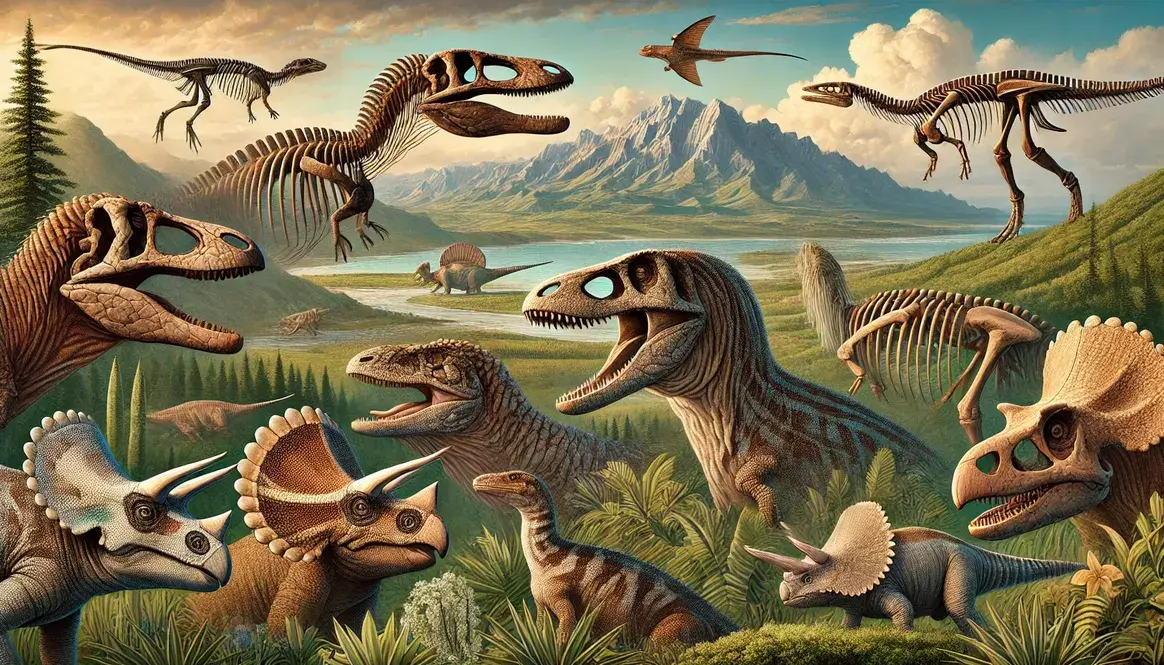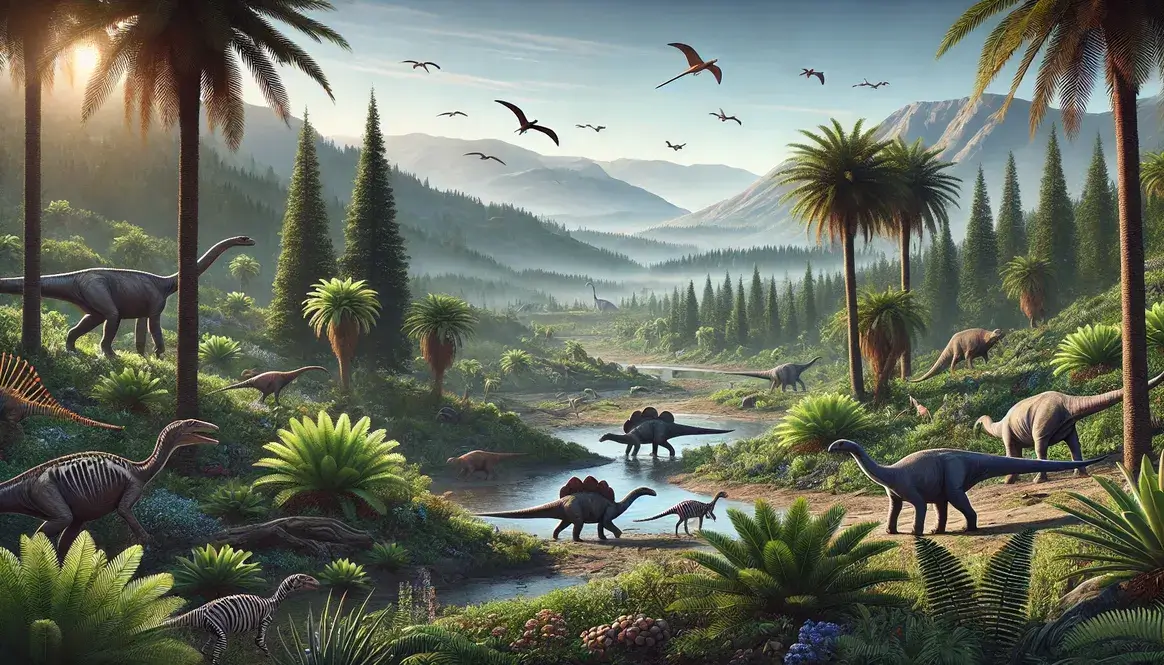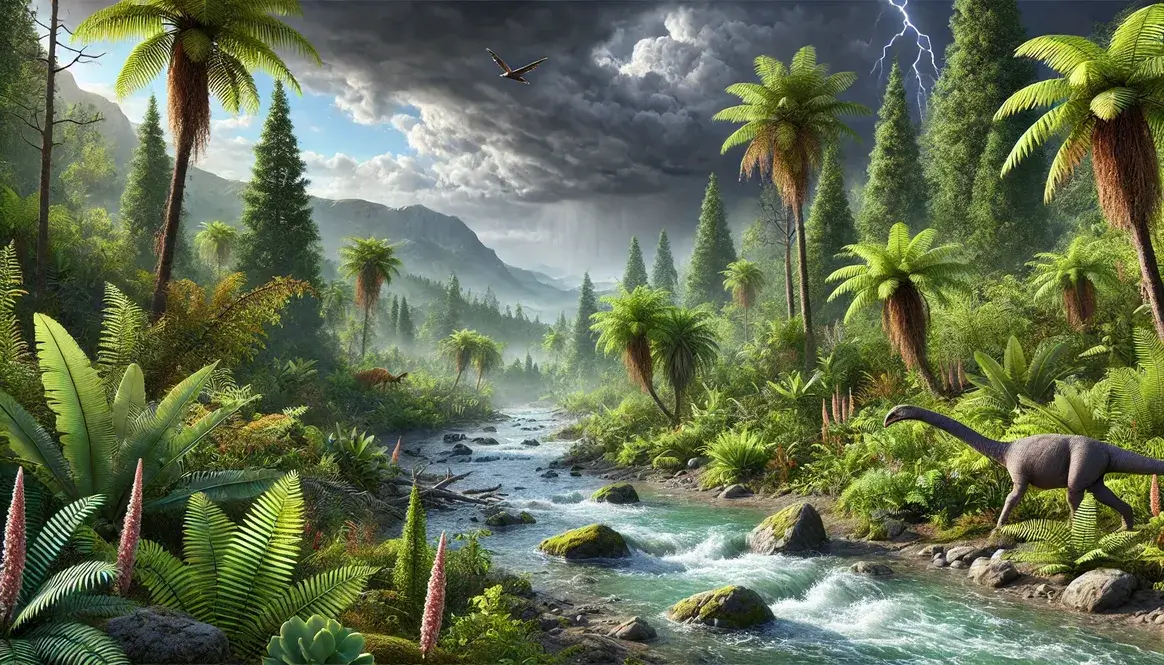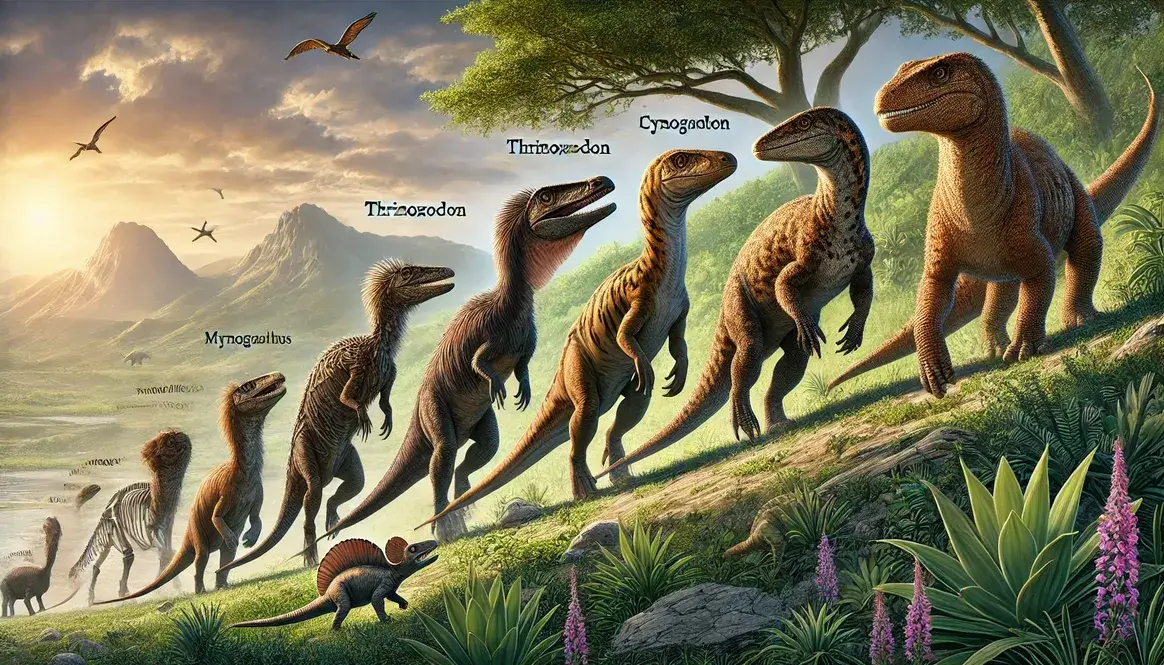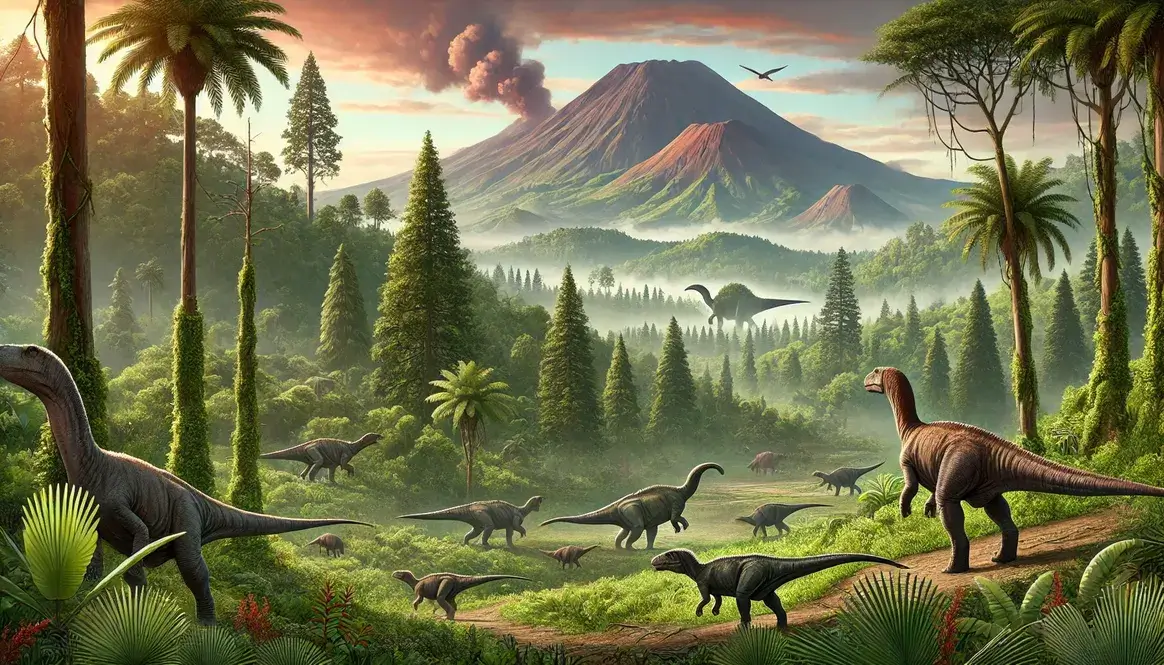The Triassic period was a time of incredible change and evolution on our planet. It marked the beginning of the dinosaur era and set the stage for the diverse life forms that would follow. In this article, we’ll explore some of the most famous Triassic fossils that have helped scientists piece together the story of this fascinating time in Earth’s history.
Coelophysis: The Early Dinosaur Star
Coelophysis holds a special place in the pantheon of famous Triassic fossils. This early dinosaur provides crucial insights into the beginnings of dinosaur evolution and has captured the imagination of paleontologists for over a century. Let’s explore why this ancient creature is such a star in the world of Triassic paleontology.
Discovery and Significance
Coelophysis is one of the rock stars of the early dinosaur world. First found in New Mexico in 1881, this small, meat-eating dinosaur became a true celebrity in the fossil world. Its name means “hollow form,” referring to its lightweight, hollow bones.
What Coelophysis Tells Us About Early Dinosaurs
Coelophysis fossils give us some big clues about early dinosaurs:
- Size: These dinosaurs were small, usually about 3 meters long.
- Build: They had a lightweight, agile body perfect for quick movements.
- Diet: Sharp teeth show they were carnivores, likely eating small animals and insects.
- Social behavior: Large numbers found together hint at possible group living.
These features tell us early dinosaurs were quick, small predators, not the giants we often think of when we hear “dinosaur.”
Ghost Ranch: A Coelophysis Treasure Trove
Ghost Ranch in New Mexico is like a Coelophysis jackpot. In 1947, hundreds of Coelophysis fossils were found here, all jumbled together. This discovery was huge! It gave scientists a chance to study many individuals of the same species, helping them understand how these dinosaurs grew and varied.
| Ghost Ranch Discovery | |
|---|---|
| Year | 1947 |
| Location | New Mexico, USA |
| Number of fossils | Hundreds |
| Significance | Large sample size for study |
| What we learned | Growth patterns, species variation |
Plateosaurus: The Dawn of Giant Plant-Eaters
Plateosaurus represents a crucial step in dinosaur evolution, marking the emergence of the long-necked, plant-eating dinosaurs that would later dominate the landscape. This famous Triassic fossil provides a window into the early days of sauropodomorph dinosaurs and the beginnings of gigantism in these remarkable creatures.
Unearthing Plateosaurus
Plateosaurus marks the beginning of the long-necked, plant-eating dinosaurs that would later become giants. First discovered in Germany in 1834, Plateosaurus was one of the earliest dinosaurs to reach a large size, growing up to 10 meters long.
Insights into Sauropodomorph Evolution
Plateosaurus fossils are like a preview of things to come. They show us:
- The start of long necks for reaching high vegetation
- Large body size, a trend that would continue in later sauropods
- Plant-eating adaptations like leaf-shaped teeth
These features help us understand how the biggest land animals ever – the sauropods – began to evolve.
Famous Plateosaurus Fossil Sites in Europe
Plateosaurus left its mark across Europe. Some famous sites include:
- Trossingen in Germany: Hundreds of well-preserved specimens
- Frick in Switzerland: Nearly complete skeletons
- Halberstadt in Germany: Multiple individuals found together
These sites give us a wealth of information about Plateosaurus and early dinosaur evolution.
Tanystropheus: The Bizarre Long-Necked Reptile
Among famous Triassic fossils, Tanystropheus stands out as one of the most peculiar. This extraordinary creature challenges our understanding of Triassic reptile diversity and adaptations. Its unique anatomy has puzzled scientists for decades and continues to provide new insights into life in the Triassic seas.
The Mystery of Tanystropheus Anatomy
Tanystropheus is one of the strangest-looking creatures from the Triassic. Imagine a reptile with a neck longer than its body and tail combined! When first discovered, scientists thought the long neck bones were leg bones because they seemed too long to be part of a neck.
What Tanystropheus Reveals About Triassic Marine Life
Tanystropheus gives us some surprising insights about Triassic sea creatures:
- Diverse body plans: The Triassic seas were full of animals with unusual body shapes.
- Specialized feeding: The long neck might have been used for catching fish while keeping the body away from the water’s edge.
- Habitat variety: Tanystropheus likely lived near the shore, showing different niches in Triassic marine ecosystems.
Notable Tanystropheus Fossil Discoveries
| Location | Year | Significance |
|---|---|---|
| Monte San Giorgio, Switzerland | 1852 | First discovery, initially misidentified |
| Besano, Italy | 1973 | Well-preserved specimens with stomach contents |
| China | 2020 | New species with different tooth shapes |
These discoveries have helped piece together the Tanystropheus puzzle, showing how this weird and wonderful creature lived in the Triassic world.
Thrinaxodon: Window into Mammal Ancestors
Ever wondered what the grandparents of mammals looked like? Meet Thrinaxodon, a creature that’s part reptile, part mammal, and all fascinating! This little animal from the early Triassic gives us a peek into how our furry ancestors got their start.
The Importance of Thrinaxodon Fossils
Thrinaxodon fossils are like a paleontologist’s dream come true. They show a mix of reptile and mammal features, giving us a front-row seat to evolution in action. Here’s what makes Thrinaxodon so special:
- Posture: It stood more upright than its ancestors, hinting at a more active lifestyle.
- Fur evidence: Fossil impressions suggest Thrinaxodon might have had whiskers, a sign that fur was evolving.
- Breathing and eating: A secondary palate allowed it to breathe while chewing, a very mammal-like trait.
These features show us an animal that was taking big steps towards becoming mammal-like, adapting to a more energetic way of life.
What Thrinaxodon Teaches Us About Synapsid Evolution
Thrinaxodon is like a stepping stone in the path from reptiles to mammals. It helps us understand:
- How mammal features developed over time
- The ways early synapsids adapted to changing Triassic environments
- The variety of mammal-like reptiles that lived during this time
This little critter shows us how our distant relatives were carving out their place in a world still ruled by reptiles.
Key Thrinaxodon Fossil Locations
| Location | Year Discovered | Significance |
|---|---|---|
| South Africa | 1894 | First and most complete specimens found here |
| Antarctica | 1970s | Shows Thrinaxodon’s wide range, supporting theories of Triassic Pangaea |
| India | 2015 | Recent finds expanding our knowledge of its distribution |
These discoveries paint a picture of a creature that was widespread during the early Triassic, adapting to various environments across the supercontinent Pangaea.
Placerias: The Massive Herbivore of Late Triassic
Imagine a creature as big as a hippo, with a beak-like mouth, wandering the Triassic landscape. That’s Placerias, one of the last great plant-eaters before dinosaurs took center stage. This gentle giant gives us a glimpse into the diverse world of large herbivores in the late Triassic.
Discovering Placerias
Placerias made its debut in the scientific world in the 1930s, when fossils were unearthed in Arizona. These bones told the story of a hefty animal, about 3 meters long and weighing up to a ton. Placerias shared its world with some of the early Triassic dinosaurs, showing just how diverse life was during this time of transition.
Placerias and the Dicynodont Legacy
Placerias belonged to a group called dicynodonts, which were the “cattle” of their time. These successful plant-eaters had been around for millions of years. Studying Placerias helps us understand:
- How large herbivores adapted to Triassic plant life
- The competition between dicynodonts and early dinosaurs
- The final chapter of these mammal-like reptiles before their extinction
Placerias represents the last hurrah of these amazing animals, giving us insights into their lifestyle and eventual fate.
Significant Placerias Fossil Finds
| Location | Year | Significance |
|---|---|---|
| Placerias Quarry, AZ | 1930s | Numerous specimens found, including many individuals |
| New Mexico | 1990s | Expanded known range of Placerias |
| Ghost Ranch, NM | 2000s | Fossils found alongside early dinosaur remains |
These discoveries have painted a vivid picture of Placerias’ world, showing how it lived alongside the rising dinosaurs in the late Triassic ecosystem.
Ichthyosaurs: Triassic Sea Dragons
Dive into the Triassic seas, and you might come face-to-face with an ichthyosaur! These “fish lizards” were some of the most impressive swimmers of their time. Their fossils tell an incredible story of how land-dwelling reptiles returned to the water and became streamlined ocean predators.
Early Ichthyosaur Fossils
The first ichthyosaur fossils caused quite a stir when they were found in the early 1800s. But it wasn’t until Triassic fossils like Utatsusaurus were discovered that we really understood their origins. These early forms show:
- Elongated, eel-like bodies
- Limbs beginning to transform into flippers
- Tails becoming more powerful for swimming
These features reveal the gradual adaptation of reptiles to a fully aquatic lifestyle.
What Ichthyosaurs Tell Us About Marine Adaptation
Ichthyosaur fossils are like a textbook on evolution. They show us:
- Bodies becoming more fish-shaped over time
- Powerful tail flukes developing for fast swimming
- Eyes growing larger for better vision in deep water
- Evidence of live birth, a key adaptation for fully marine animals
These changes mirror what we see in modern marine animals like dolphins, showing how similar adaptations can evolve in different groups.
Famous Ichthyosaur Fossil Sites
| Location | Famous For |
|---|---|
| Holzmaden, Germany | Exceptionally preserved specimens with soft tissues |
| British Columbia, Canada | Early Triassic transitional forms |
| Nevada, USA | Fossils of giant ichthyosaurs from the late Triassic |
These sites have given us a wealth of information about ichthyosaur evolution and diversity throughout the Triassic period.
Triassic Plant Fossils: The Greening of Earth
While dinosaurs often steal the spotlight, Triassic plant fossils are the real unsung heroes of this ancient world. These plants set the stage for all the amazing animals we’ve talked about, providing food and shaping the landscapes of the Triassic.
Key Triassic Plant Fossil Discoveries
The Triassic was a time of big changes in the plant world. Some key discoveries include:
- Seed ferns: These now-extinct plants were diverse and widespread
- Early conifers: The granddaddies of modern pine trees were taking root
- Cycads: These palm-like plants were common sights in the Triassic landscape
- Ginkgoes: Relatives of the modern Ginkgo biloba were just getting started
These plants show us how the green world was changing and adapting alongside the animals.
What Plant Fossils Reveal About Triassic Ecosystems
Triassic plant fossils are like time machines, transporting us back to ancient forests and plains. They tell us about:
- The Triassic climate and how it changed over millions of years
- What kinds of food were available for plant-eating animals
- How plants recovered and diversified after the great Permian extinction
By studying these plants, we can better understand the world that Triassic animals lived in.
Notable Triassic Plant Fossil Locations
| Location | Famous For |
|---|---|
| Petrified Forest, Arizona | Beautifully preserved fossilized wood |
| Ipswich Coal Measures, Australia | Rich diversity of Triassic plant fossils |
| Madygen Formation, Kyrgyzstan | Well-preserved leaves, including early ginkgoes |
These sites give us windows into different Triassic ecosystems around the world.
The Impact of Famous Triassic Fossils
Famous Triassic fossils have completely changed how we see this crucial time in Earth’s history. They show us a world in transition, where the first pterosaurs took to the skies, early dinosaurs began their rise to power, and the ancestors of mammals were trying out new ways of life.
These fossils paint a picture of incredible diversity. From the weird, long-necked Tanystropheus to the powerful ichthyosaurs ruling the seas, life was taking on all sorts of new forms. By studying these remains, scientists can piece together:
- How animals and plants evolved after Earth’s biggest mass extinction
- The ways changing climates affected life
- What might have caused the end-Triassic extinction
Each new fossil discovery is like adding a piece to a giant puzzle, helping us see more clearly what Earth was like in the Triassic.
The story these fossils tell is one of resilience and adaptation. Life bounced back from near-destruction at the start of the Triassic, evolving into new forms and filling new niches. The Triassic set the stage for the Age of Dinosaurs and beyond, making it a crucial chapter in the history of life on Earth.
As we continue to study these ancient remains, who knows what new secrets we’ll uncover about our planet’s fascinating past?

